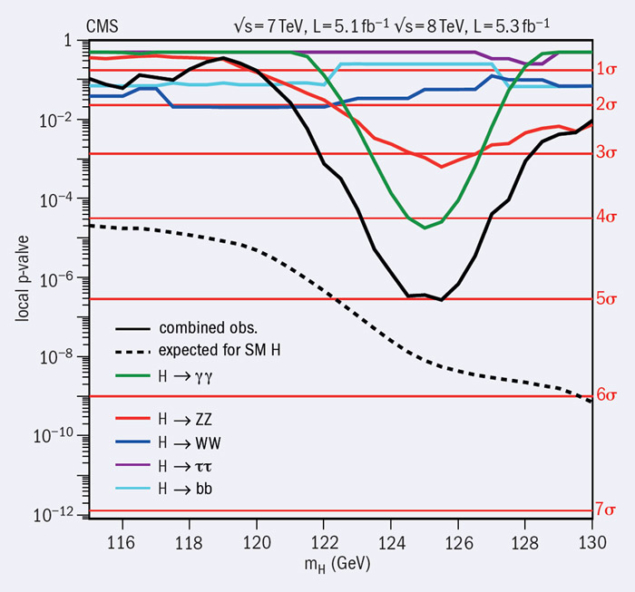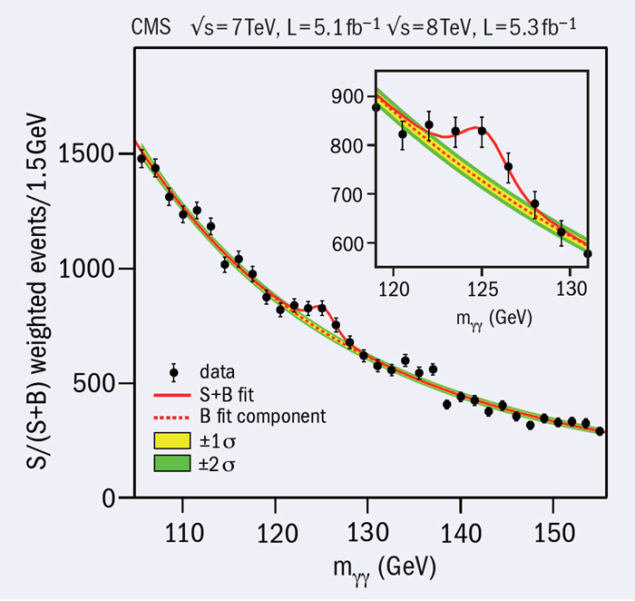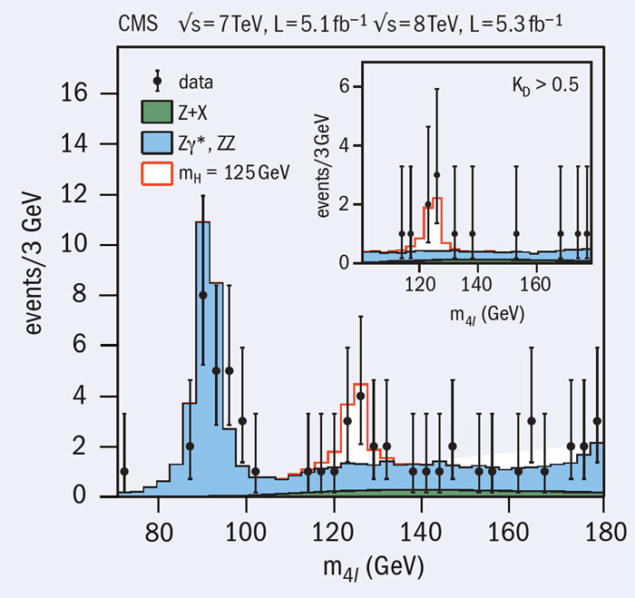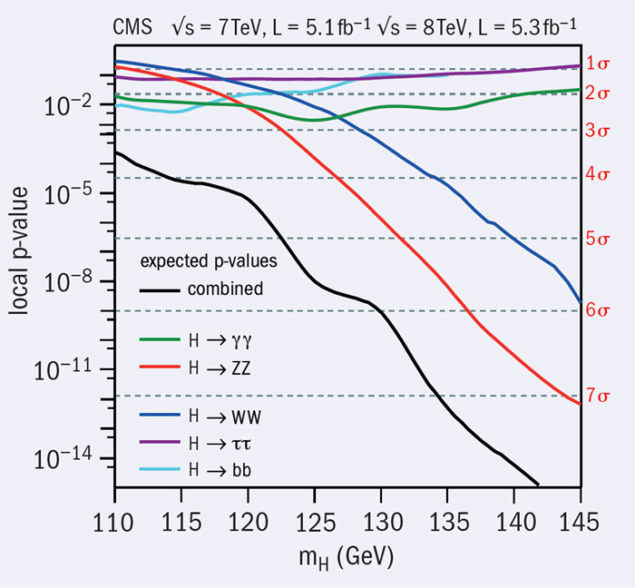
9.35 a.m. 4 July 2012. In front of an expectant crowd packing CERN’s main auditorium, Joseph Incandela shows a slide on behalf of the CMS collaboration; its subject, the combination of the two search channels with the best mass resolution, H→γγ and H→ZZ→ 4 leptons (llll). The slide shows a clear excess that corresponds to 5 σ above the expected background, signalling the discovery of a new particle. The audience erupts into applause. These decay modes not only give a measure of the mass of the new particle as 125 +/– 0.6 GeV but also reveal that it is, indeed, a boson, meaning a particle with integer spin; the two-photon decay mode further implies that its spin must be different from 1 (figure 1).
The ideas that led to the announcement were seeded more than 20 years ago
The search for the Standard Model Higgs boson, the missing keystone of the current framework for describing elementary particles and forces, has been going on for some 40 years. The ideas that led to the 4 July announcement were seeded more than 20 years ago: in 1990, at the Aachen workshop where people first heard the term “Compact Muon Solenoid”, and where people such as Michel Della Negra and Tejinder Virdee – the founding fathers of the CMS collaboration – presented quantitative ideas on how the Higgs boson, if it existed, could be found at the LHC. They aimed to provide coverage down to the region of low mass, which required precision tracking and electromagnetic calorimetry.
A measure of the performance of CMS, its hardware, software, distributed computing, analysis systems and the inventiveness of the people doing the analysis, can be gauged by the fact that a discovery of a Higgs-like boson has been made at half of the design energy of the LHC, using one-third of the integrated luminosity and under fiercer than the design “pile-up” conditions that were foreseen in the pre-data-taking estimates for reaching such a significance. This success is a real tribute to the thousands of CMS physicists and several generations of students who have turned CMS from a proposal on paper to a scientific instrument, hors du commun, producing frontier physics.
On 4 July the CMS collaboration presented searches for the Standard Model Higgs boson in five distinct decay modes: γγ, ZZ→llll, WW→lνlν, ττ and bb, the so-called high-priority analyses. The 2012 data-taking campaign and physics analyses had been under preparation since the end of 2011. The CMS collaboration had been pushing to go to 8 TeV collision energy and, assuming that this would happen, started the data simulation at 8 TeV in December. The collaboration identified 21 high-priority analyses, including the ones for the Higgs searches. The reconstruction software was improved and the trigger menus prepared to select with high efficiency the events necessary for the search. The software and computing resources were for the most part dedicated to the high-priority analyses.
The limits on the Higgs boson mass, established by experiments at CERN’s Large Electron–Positron collider and Fermilab’s Tevatron, and by the LHC campaign in 2011, showed that the Standard Model Higgs boson, if it existed, would most likely inhabit the mass range 114.4–127 GeV. Another important strategic decision was to re-optimize and improve the analyses using the expected sensitivity as the driving criterion. The entire analysis procedure in each individual analysis was assessed on the basis of maximizing sensitivity without looking into the above-mentioned mass region – in other words, they were “blind”. This would inevitably lead to a day of high drama when the “unblinding” was to take place, on 15 June.
The unblinding procedure, defined before 2012 data-taking, was to proceed in two steps:
• The performance of the analyses would be evaluated and pre-approved by the collaboration based on the first 3 fb–1 of data that had been collected and fully certified. On 15 June, the results in the blinded region would be shown. The deadline of 15 June arrived and all analyses were declared ready by the analysis review committees and on seeing the results from the high mass-resolution channels most of the hundreds present at CERN or connected via videoconferencing were astounded – there were the first clear signs that a new particle could be coming into view. The indications seen in the 2011 data not only remained, but were strengthened. A day of excitement indeed!
• From 15 June onwards the analyses would be – and were – simply topped-up, once the data quality-certification process was completed. They would eventually include all of the data available up until the technical stop of the LHC planned for late June.

Expectations started to increase, especially when observing the fantastic performance of the LHC, which was delivering collisions at a record rate. At the same time, the considerable increase in sensitivity of all five analyses, compared with those of 2011, meant that a discovery became a real possibility. In particular, the H→ττ channel had improved in sensitivity by more than a factor of two and H→bb was also starting to contribute. All of the analyses had integrated multivariate analysis methods for selection and/or reconstruction to optimize use of the full event information, leading to improved sensitivity. The channels with high mass-resolution, H→γγ and H→ZZ→llll, achieved close-to-design resolutions, e.g. for the best categories of events, 1.1 GeV and <1 GeV for diphoton and four-lepton states, respectively (figures 2 and 3). The anticipated number of standard deviations (σ) for the expected significance came out close to 6 σ (median) using 5 fb–1 from each of the 7 TeV and 8 TeV data sets (figure 1). A higher (lower) observed significance would indicate an upwards (downwards) fluctuation of this expectation.

All of the five high-priority analyses were performed independently at least twice. Furthermore, improvements in the definition and selection of the physics objects were subjected to scrutiny and formal approval before deployment.
As every new batch of certified data was added, the analysts eagerly looked forward to updates. The final word would belong to the team responsible for combining the results from the five high-priority analyses, the combination procedure having been validated before the unblinding.
The combination of these five analyses reveals an excess of events above the expected background, with a maximum local significance of 5.0 σ at a mass of 125.5 GeV. The expected significance for a Standard Model Higgs boson of that mass is 5.8 σ. The signal strength σ/σSM was measured to be 0.87+/– 0.23, where σ/σSM denotes the production cross-section multiplied by the relevant branching fraction, relative to the Standard Model expectation.

Having clearly seen a new particle, considerable attention was then devoted to measuring properties such as mass, spin if possible, and its couplings to bosons and fermions. All in all, the results presented by CMS are consistent, within uncertainties, with expectations for a Standard Model Higgs boson. With the recent decision to extend the 2012 data-taking by 55 days, the collaboration is now eager to accumulate up to three times more data, which should enable a more significant test of this conclusion and an investigation of whether the properties of the new particle imply physics beyond the Standard Model.
This will prove to be the discovery of a particle sans precedent. If it is confirmed to be a fundamental scalar (spin 0) then it is likely to have far-reaching consequences on physicists’ thinking about nature. It would be the first fundamental scalar boson. It is known that fundamental scalar fields play an important role not only in the presumed inflation in the early instants of the universe but also in the recently observed acceleration of its expansion. There can be no doubt that exciting times lie ahead.
• For more, see the paper on these results from CMS.
To explore all our coverage marking the 10th anniversary of the discovery of the Higgs boson ...





